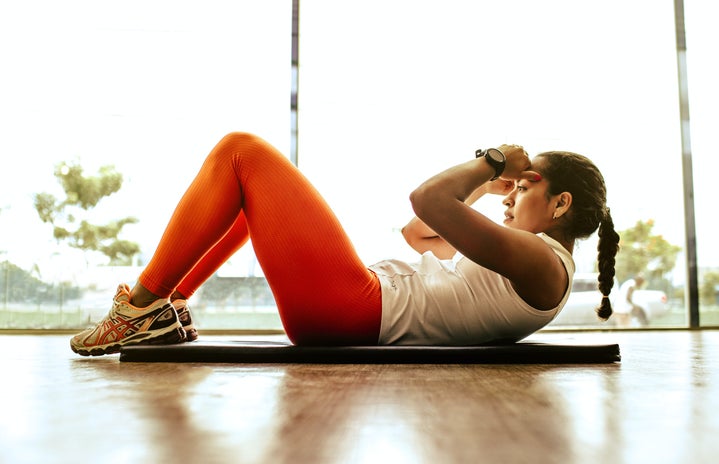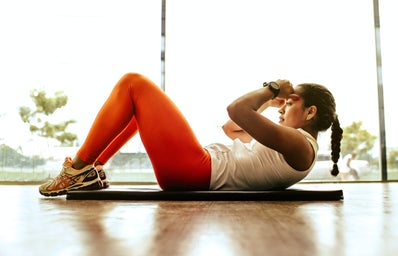Wanna know the secret to killer legs and a great butt? And, even better, it’s something that is done primarily sitting down?
This holy grail workout that I’m referring to is cycling, specifically on a stationary bike. Whether you take a cycle class or you just hop on a stationary bike by yourself at the gym, this workout will leave your legs screaming and your glutes more toned than ever.
By combining cardio, legs, butt and even core, cycling is ideal for anyone who isn’t really into running or just wants to try something a little different.
Here is everything you need to know about cycling in order to get started, as well as a few tips. Warning: Spin classes are super addicting, so be prepared to fall in love with a workout like you would never believe.
How It Works
Indoor cycling classes, often referred to as spin classes, take place in a room where each person works out on their own stationary bike provided. A common misconception is that there is no resistance on a stationary bike and the goal is to just pedal as fast as you can for as long as you can, but this is most definitely not the case.
Each bike will have some way to increase resistance, most likely by lifting a lever on the bike, thus making it more and more difficult to pedal the bike. Most spin classes are taught using intervals where you alternate from high speed on light resistance to low speed on heavy resistance.
All About That Bike (Set Up)
Before you even mount the bike, the first thing to do is adjust the bike, including adjusting seat height and distance from the handlebar, handlebar height and finally strapping your feet onto the pedals.
1. Seat Height and Distance
Stand directly beside the bike facing the handlebars. Your hip bone should be directly in line with the top of the seat, so adjust the height as needed. Next, mount the bike and adjust the seat so that it is directly over the pedals and comfortable for you when reaching for the handlebars.
2. Handlebar Height
This step is a little bit trickier. The best way to do this is to simply mount the bike and decide where you feel the most comfortable holding on. You should not be resting all your weight on the handlebar, but it should not be too far away so that you have to reach out to hold on.
3. Foot Straps
Once you have adjusted the bike, you must next strap your feet onto the pedals of the bike to avoid them slipping off during your ride. Simply place your feet in the foot harness and tighten completely.
The Guide to the Ride
If you are taking a spin class, the instructor should explain how to read the numbers on the monitor of your bike, but just in case he or she doesn’t, here’s a quick overview.
1. RPMs are your revolutions per minute (the amount of times you pedal a full circle in a minute)
2. Watts show the amount of effort you are putting into the pedals in numerical form.
3. The resistance number is the amount of resistance on the bike that makes it harder and harder to pedal.
Hills on a Stationary Bike?
When the instructor refers to hills, he or she is referring to how much resistance is on the bike. The higher the resistance, the “heavier” the hill.
1. Find your flat road.
This can be done by starting to pedal and adding on resistance until you feel a slight resistance when you are pushing against the pedals, as if you were riding a bike on a flat road. Your effort level should be very light. Typically, the flat road can be found between 6 and 12 resistance, depending how long you’ve been cycling.
2. Increase to a small hill.
A small hill is usually two to four gears above the flat road. Your effort level should rise slightly, and RPMs should still be relatively high (around 90).
3. Then the medium hill.
A medium hill is usually four to six gears above the flat road. Your effort level should be moderate, and RPMs should be around 70-85.
4. Finally, the dreaded heavy hill.
A heavy hill is usually six to ten gears above the flat road. Your effort level should be high here, and RPMs will be low (in the 60-70 range).
Positions In and Out of the Saddle
No, this has nothing to do with horses, but rather with whether you are sitting or standing while on the bike.
1. First position
This means you are riding seated (in the saddle). This will most likely be the position you will be in the most throughout the ride.
2. Second position
Now you are standing straight up (out of the saddle) and pedaling. Your shoulders should be over your hips, and there should be little to no weight on the handlebars.
3. Third position
This position is also out of the saddle, except now your butt is further over the seat and your upper body is bent at the hips and hovering over the handlebars. There should still be little to no weight in the handlebars, and you should feel this in the back of your legs and butt.
Sprint! Then recover.
Part of interval training is having 30-second to a minute long “sprints” throughout your ride. This serves to raise your heartrate quickly and can be achieved by raising resistance or RPMs or both. After sprints, there should be a recovery, where you can let your legs drift and lower your resistance back to your flat road. Recovery is an important part of effective interval training, so don’t skip it!
There’s a lot that goes into cycling, as you can see, but after a few classes you’ll not only get the hang of it, but you’ll also be hooked.
Cycling has become my favorite form of exercise, and by combining it with a quick arm/back session, you can get the perfect full-body workout.
Photo credit:
Mindlifeproject.com

